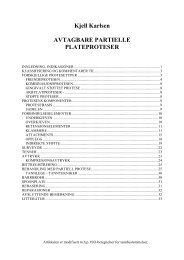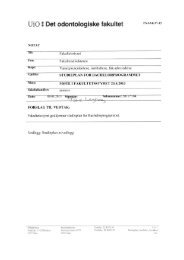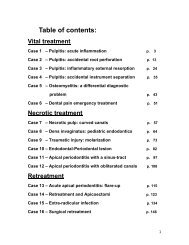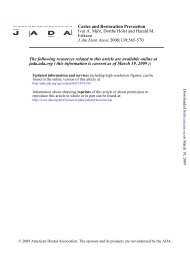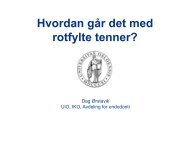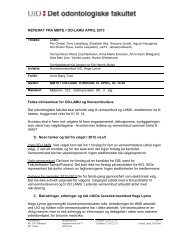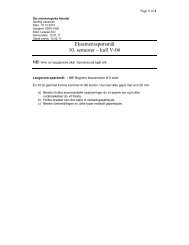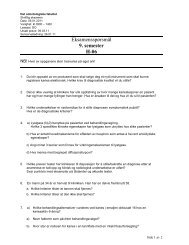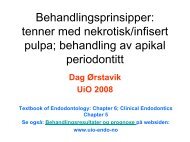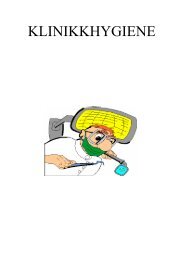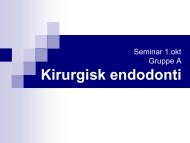Cost-effectiveness of various treatment modalities for adult chronic ...
Cost-effectiveness of various treatment modalities for adult chronic ...
Cost-effectiveness of various treatment modalities for adult chronic ...
You also want an ePaper? Increase the reach of your titles
YUMPU automatically turns print PDFs into web optimized ePapers that Google loves.
Periodontology 2000, Vol. 51, 2009, 269–275Printed in Singapore. All rights reservedÓ 2009 John Wiley & Sons A/SPERIODONTOLOGY 2000<strong>Cost</strong>-<strong>effectiveness</strong> <strong>of</strong> <strong>various</strong><strong>treatment</strong> <strong>modalities</strong> <strong>for</strong> <strong>adult</strong><strong>chronic</strong> periodontitisPER E. GJERMO &JOSTEIN G RYTTENThe aim <strong>of</strong> this review was to assess the cost-<strong>effectiveness</strong><strong>of</strong> <strong>various</strong> <strong>modalities</strong> <strong>for</strong> <strong>chronic</strong> periodontitisin <strong>adult</strong>s. We searched the literature <strong>for</strong> studieswhere time consumption and monetary costs (whereavailable) were used as expressions <strong>of</strong> the resourcesrequired to per<strong>for</strong>m the following types <strong>of</strong> services:providing in<strong>for</strong>mation on the disease and oralhygiene instruction <strong>for</strong> patients; removal <strong>of</strong> subgingivalcalculus; access surgery; and maintenance andprevention <strong>of</strong> recurrence <strong>of</strong> the disease. The followingoutcome variables were chosen: retention <strong>of</strong> teeth, ora surrogate variable such as change in bone levelmeasured on X-rays taken at the start and at the end<strong>of</strong> a 1-year (or longer) period. The literature searchdid not reveal any studies where these outcomevariables could be linked to in<strong>for</strong>mation on resourcesused in <strong>treatment</strong>. There<strong>for</strong>e, we reviewed relevantstudies where different <strong>treatment</strong> techniques wereused but where the outcome variables were different.This review revealed that in most cases it was difficultto assess whether one type <strong>of</strong> <strong>treatment</strong> (or intervention)is more effective than another. We concludethat better data are needed, in particular on outcomes,so that valid comparisons can be made betweendifferent types <strong>of</strong> <strong>treatment</strong>, <strong>for</strong> different types<strong>of</strong> studies.Periodontal disease is an inflammatory diseaseinduced by bacterial plaque adhering to the toothsurface in contact with the gingiva. A lesion that iscontained in the gingival margin is termed gingivitis.Gingivitis may be regarded as the result <strong>of</strong> animmunologic reaction and as an attempt by theorganism to prevent the development <strong>of</strong> the tissuedestructivecomponent <strong>of</strong> periodontal disease calledperiodontitis. Gingivitis will always precede periodontitis,but its development into periodontitisis rare (50). The development <strong>of</strong> gingivitis intoperiodontitis is multifactorial and is believed tooccur in susceptible individuals where homeostasisis not successfully established by the host. Periodontitisis characterized by the loss <strong>of</strong> periodontalfibers and alveolar bone, eventually leading to theloss <strong>of</strong> teeth. The course <strong>of</strong> the disease and the rate<strong>of</strong> progression are affected by genetic and environmentalfactors. These comprise variation in theamount <strong>of</strong> bacteria (oral hygiene) and their compositionin plaque (63), some medical disorders(human immunodeficiency virus, diabetes) anddrugs affecting the immune system (steroids, calciuminhibitors) (34). In addition, life-style factors,such as tooth-cleaning habits (58) and tobaccoconsumption (9), seem to play an important role indetermining susceptibility to, and the rate <strong>of</strong> progression<strong>of</strong>, the disease. As a result <strong>of</strong> its <strong>chronic</strong>character and the fact that the bacteria causing themost common <strong>for</strong>ms <strong>of</strong> periodontitis are microorganismsthat are endogenous in the human oralflora (and probably important <strong>for</strong> prevention <strong>of</strong> otherinfections by exogenous bacteria), periodontitis has apropensity <strong>for</strong> recurrence after <strong>treatment</strong>. In fact, theonly predictable method to eradicate periodontaldisease in a patient is to extract all teeth. However, inspite <strong>of</strong> this as a <strong>treatment</strong> option, which wouldprobably be very cost-effective and one that has beenconsidered in special circumstances (17), it will notbe considered in this review.Treatment <strong>of</strong> periodontitis has been directed towardsthe changeable risk factors, first and <strong>for</strong>emostoral hygiene and, in the later years, smokinghabits. The pr<strong>of</strong>essional removal <strong>of</strong> bacterial plaquefrom the tooth surfaces is crucial in all <strong>for</strong>ms <strong>of</strong>periodontal <strong>treatment</strong>, and training patients in thedaily self-removal <strong>of</strong> plaque is an essential part<strong>of</strong> prevention <strong>of</strong> disease recurrence following269
Gjermo & Grytten<strong>treatment</strong> (33). The effect <strong>of</strong> tobacco consumptionhas become more and more evident over the lastfew decades (9), particularly concerning the moresevere <strong>for</strong>ms <strong>of</strong> periodontitis (22). There<strong>for</strong>e,counseling regarding smoking and other <strong>for</strong>ms <strong>of</strong>tobacco use has become very important in combatingthis <strong>chronic</strong> disease. The <strong>treatment</strong> <strong>of</strong>periodontitis thus includes changing life styles <strong>for</strong>life, because the risk <strong>of</strong> recurrence will always followa susceptible host, thus making the <strong>treatment</strong>approach particularly complex, involving manypsychological aspects (12, 56).The successful <strong>treatment</strong> <strong>of</strong> periodontitis is believedto prevent further progression <strong>of</strong> the tissuedestructiveprocesses involved (13), not necessarilyto obtain an Ôinflammation-freeÕ gingival margin.Regeneration <strong>of</strong> lost tissue may occur, but this is rareand <strong>of</strong> little magnitude, and is there<strong>for</strong>e usually not ageneral goal <strong>for</strong> <strong>treatment</strong>. There is, however, noagreement on how to assess <strong>treatment</strong> success. N<strong>of</strong>urther tooth loss, or retention <strong>of</strong> teeth during adefinite time span, would be parameters that aretangible <strong>for</strong> patients (10, 26). As periodontitis developsvery slowly, even without <strong>treatment</strong> (39, 40), thisis difficult to assess in clinical trials. However, a fewstudies have been conducted with fairly long observationperiods and adequate outcome variables,un<strong>for</strong>tunately without cost-<strong>effectiveness</strong> aspects includedwithin their design (3, 20, 51). A conceptnamed quality-adjusted tooth-years (QATYs) hasbeen suggested (1), but this needs further developmentand testing be<strong>for</strong>e it can be recommended.Consequently, surrogate variables are used. The mostcommon surrogate variables are strongly related tothe degree <strong>of</strong> inflammation <strong>of</strong> the periodontal tissues,such as bleeding on probing, probing pocket depthand clinical attachment level. Un<strong>for</strong>tunately, thedegree <strong>of</strong> inflammation is only vaguely predictive <strong>of</strong>future loss <strong>of</strong> supporting tissues and teeth (36, 57).Probably, a stable bone level, as assessed on radiographs,is the most valid assessment <strong>of</strong> no progression(27), but because <strong>of</strong> the slow development <strong>of</strong> thedisease in question, even studies with bone loss asthe outcome variable might require several years toprovide valid in<strong>for</strong>mation about the effect <strong>of</strong> <strong>various</strong><strong>treatment</strong> approaches.The systematic <strong>treatment</strong> <strong>of</strong> periodontitis thusincludes thorough in<strong>for</strong>mation about the disease,the causes and contributing factors (smoking, etc.),and the impact <strong>of</strong> personal oral hygiene in additionto the pr<strong>of</strong>essional removal <strong>of</strong> supragingival andsubgingival plaque, calculus and overhangs on restorationsand crowns (retention factors) (debridement).In order to obtain access to subgingival rootsurfaces, surgery may be necessary (33, 66). Thismay comprise gingivectomy (removal <strong>of</strong> the gingivacovering the root surfaces) or flap procedures wherethe flaps are replaced and sutured after scaling androot planing. Treatment with antibiotics, eitherlocally or systemically, is recommended in somecases (30, 43, 45, 48, 61, 64). In addition, otherantimicrobial agents have been suggested (15, 18,24, 31).For mechanical debridement <strong>of</strong> the root surfaces anumber <strong>of</strong> techniques and instruments have beendeveloped, as well as suggestions on whether to treatthe entire oral cavity in one setting (to avoid contaminationfrom untreated sites) (52), or to divide themouth into either sextants or quadrants that aretreated sequentially with weeks interval betweeneach session. Also, the sequence <strong>of</strong> <strong>treatment</strong>s havebeen subject to discussions about, <strong>for</strong> instance,whether it is necessary to obtain a certain level <strong>of</strong> oralhygiene be<strong>for</strong>e <strong>treatment</strong> planning, or whether prescalingbe<strong>for</strong>e surgery should be recommended (6).However, few studies including the economic aspects<strong>of</strong> the <strong>various</strong> approaches have been conducted,and in those that have been carried out, thevalidity is <strong>of</strong>ten limited to one country and its socialand economic situation, the peopleÕs needs andrequirements, and the national system <strong>for</strong> deliveringand paying <strong>for</strong> health services; there<strong>for</strong>e, thesestudies have limited general validity. Some studieshave estimated the time needed <strong>for</strong> per<strong>for</strong>ming <strong>various</strong>periodontal <strong>treatment</strong> procedures as an expression<strong>of</strong> resources needed. In the present review wewill regard both time consumption and monetarycosts as expression <strong>of</strong> resources required to per<strong>for</strong>m<strong>treatment</strong> <strong>modalities</strong>.Johansen et al. (28) presented the PeriodontalTreatment Need System (PTNS) which is based onthe three basic procedures: motivation and instructionin effective oral hygiene measures; subgingivaldebridement <strong>of</strong> the root surfaces <strong>of</strong> periodontallyinvolved teeth; and debridement facilitated bysurgery. The resources needed <strong>for</strong> each <strong>of</strong> thesetherapeutic measures were calculated as time consumption(7), and hypothetically applied to severalpopulations (8, 29). In a later study, Mubarak &Gjermo (46) showed that the results were alsoapplicable to patients actually treated and withacceptable accuracy. However, the PeriodontalTreatment Need System does not consider maintenance,which is regarded as an important and integralpart <strong>of</strong> periodontal <strong>treatment</strong> and crucial <strong>for</strong>long-term success (37, 38).270
Gjermo & GryttenSubgingival debridementSubgingival debridement is the cornerstone <strong>of</strong> allperiodontal <strong>treatment</strong> (33), and many studies confirmits <strong>effectiveness</strong> in controlling mild to moderateperiodontitis (pockets £ 5 mm) (41, 62), (2–4, 20, 35,51). For this purpose, <strong>various</strong> techniques andinstruments, both manual and machine driven, havebeen developed and their effect compared (14, 19, 60,65). The majority <strong>of</strong> studies show only marginal differencesin outcome and time consumption <strong>for</strong> per<strong>for</strong>mingthe <strong>various</strong> procedures (59, 67). One recentreview indicates that ultrasonic instrumentation <strong>of</strong>single-rooted teeth may yield a time gain as comparedwith manual debridement (65). However, becausethe equipment necessary <strong>for</strong> ultrasonic, laseror other machine-driven instruments infers extracosts, scaling and root planing with manual scalersmay be regarded as the most cost-effective <strong>treatment</strong>modality <strong>for</strong> mild and moderate disease. In severecases <strong>of</strong> periodontitis, adjunctive antibacterial <strong>treatment</strong>(systemically or locally applied) seems toprovide a small additional benefit (23, 45, 48, 64).However, while the adjunctive use <strong>of</strong> systemicallyapplied antibiotics may be relatively cheap, the costs<strong>for</strong> single tooth <strong>treatment</strong> with local drug-deliverysystems are not negligible (10). Full-mouth debridement(52), used in combination with systemic antibiotics,has shown a small, but clinically insignificant,advantage over the conventional approach (37, 38).For severe periodontitis (periodontal pockets‡ 6 mm), closed nonsurgical <strong>treatment</strong> may beinsufficient to arrest the disease, although this isgenerally recommended as the first <strong>treatment</strong> approach.The result <strong>of</strong> the nonsurgical approach mustthen be evaluated and surgery per<strong>for</strong>med if satisfactoryresults are not obtained (33). From a cost<strong>effectiveness</strong>perspective this approach will addto the costs when surgery is necessary, compared tothe costs if surgery had been per<strong>for</strong>med immediately(6, 7).Access surgeryIn the <strong>treatment</strong> <strong>of</strong> <strong>chronic</strong> periodontitis, periodontalsurgery is per<strong>for</strong>med to obtain access to affected rootsurfaces <strong>for</strong> the removal <strong>of</strong> calculus and bi<strong>of</strong>ilm (68).This may be obtained by gingivectomy or <strong>various</strong> flapprocedures. The type <strong>of</strong> procedure chosen does notinfluence the outcome when this is assessed as n<strong>of</strong>urther progression <strong>of</strong> the disease, provided thatoptimal plaque control is maintained by the patient(55). However, lack <strong>of</strong> plaque control after periodontalsurgery always results in failure (49), regardless<strong>of</strong> the surgical technique employed. This wouldtend to favor gingivectomy as a result <strong>of</strong> the simplicity<strong>of</strong> the method that probably renders itthe more cost-effective option. However, other aspects,such as unwanted side effects (sensitivity,cosmetics), may be influenced by the technique usedand should be evaluated when the choice is made.There are indications that prescaling be<strong>for</strong>e surgerymay require more time than debridement after surgery(7). This would make it cost-effective to per<strong>for</strong>msurgery without prescaling if it is obvious that surgerywill be needed. It has been suggested that per<strong>for</strong>mingscaling during or after surgery requires less time thana systematic subgingival debridement (6, 7). Thedifficulty is that there are no absolute criteria todetermine when surgery would be indicated.Adjunctive systemic antibiotics have been shownto <strong>of</strong>fer some advantage to the <strong>treatment</strong> outcome insevere periodontitis cases and in refractory periodontitis(45, 64), but a recent report questions theusefulness in combination with surgical approaches(23). However, the increased cost <strong>of</strong> a single course <strong>of</strong>antibiotics does not influence the total cost <strong>of</strong> <strong>treatment</strong>in a way that would be decisive <strong>for</strong> the cost<strong>effectiveness</strong><strong>of</strong> the <strong>treatment</strong>.Maintenance and prevention <strong>of</strong>recurrenceThere is widespread agreement in the literature thatpatients treated <strong>for</strong> periodontitis require life-longmaintenance, with needs-related supportive care,which includes rein<strong>for</strong>cement <strong>of</strong> oral hygienepractices, scaling and prophylaxis (20, 37, 38). It isdisputed how <strong>of</strong>ten these maintenance sessions arerequired, but there are indications that several timesper year is no better than once a year and the value <strong>of</strong>routine pr<strong>of</strong>essional removal <strong>of</strong> plaque has beenquestioned when patientsÕ home care is adequate (5).Also, there are indications that the outcome <strong>of</strong> supportiveperiodontal care is better when taken care <strong>of</strong>by specialists, compared with general practitioners,but at a higher cost (21). Noncompliance with amaintenance program, however, predictably resultsin the recurrence <strong>of</strong> the disease (49). Local application<strong>of</strong> antibiotics in affected pockets duringmaintenance care has been suggested (61), but at ahigher cost (10) and with an increased risk <strong>of</strong>developing antibiotic resistance. It seems conceivablethat cost-<strong>effectiveness</strong> gains may be obtained inmaintenance programs, but thus far data are scarceand inconclusive.272
Gjermo & Grytten23. Herrera D, Alonso B, León R, Roldán S, Sanz M. Antimicrobialtherapy in periodontitis: the use <strong>of</strong> systemicantimicrobials against the subgingival bi<strong>of</strong>ilm. J Clin Periodontol2008: 35(Suppl. 8): 45–66.24. Hoang T, Jorgensen MG, Keim RG, Pattison AM, Slots J.Povidone-iodine as a periodontal pocket disinfectant.J Periodontal Res 2003: 38: 311–317.25. Hugoson A, Lundgren D, Asklöw B, Borgklint B. The effect<strong>of</strong> different dental health programmes on young <strong>adult</strong>individuals. A longitudinal evaluation <strong>of</strong> knowledge andbehaviour including cost aspects. Swed Dent J 2003: 27:115–130.26. Hujoel PP, Powell LW, Kiyak HA. The effects <strong>of</strong> singleinterventions on tooth mortality: findings in one trialand implications <strong>for</strong> future studies. J Dent Res 1997: 76:867–874.27. Hujoel PP, Löe H,Ånerud Å, Boysen H, Leroux BG. Thein<strong>for</strong>mativeness <strong>of</strong> attachment loss on tooth mortality.J Periodontol 1999: 70: 44–48.28. Johansen JR, Gjermo P, Bellini HT. A system to classify theneed <strong>for</strong> periodontal <strong>treatment</strong>. Acta Odontol Scand 1973:31: 297–305.29. Johansen JR, Gjermo P, Haugen E. The need <strong>for</strong> periodontal<strong>treatment</strong> in an urban population. J Clin Periodontol 1975:2: 226–230.30. Jorgensen MG, Slots J. The ins and outs <strong>of</strong> periodontalantimicrobial therapy. J Calif Dent Assoc 2002: 30: 297–305.31. Kaner D, Bernimoulin J-P, Hopfenmüller W, Kleber B-M,Friedmann A. Controlled-delivery chlorhexidine chip versusamoxicillin ⁄ metronidazole as adjunctive antimicrobialtherapy <strong>for</strong> generalized aggressive periodontitis: a randomizedcontrolled clinical trial. J Clin Periodontol 2007:34: 880–891.32. Killoy WJ, Love JW, Love JD, Tira DE. Clinical and cost<strong>effectiveness</strong> <strong>of</strong> the counter-rotational brush in privatepractice. Compend Contin Educ Dent 1993: 14(Suppl 16):599–605.33. Kinane DF, Lindhe J, Trombelli L. Chronic periodontitis. In:Lindhe J, Lang NP, Karring T editors. Clinical periodontologyand implant dentistry, 5th edn. Ox<strong>for</strong>d: BlackwellPublishing Ltd, 2008: 420–427.34. Kinane DF, Berlundh T, Lindhe J. Pathogenesis <strong>of</strong> periodontitis.In: Lindhe J, Lang NP, Karring T editors. Clinicalperiodontology and implant dentistry, 5th edn. Ox<strong>for</strong>d:Blackwell Publishing Ltd, 2008: 286–306.35. Knowles JW, Burgett FG, Nissle RR, Shick RA, Morrison EC,Ramfjord SP. Results <strong>of</strong> periodontal <strong>treatment</strong> related topocket depth and attachment level. Eight years. J Periodontol1979: 50: 225–233.36. Lang NP, Joss A, Tonetti MS. Monitoring disease duringsupportive periodontal <strong>treatment</strong> by bleeding on probing.Periodontol 2000 1996: 12: 44–48.37. Lang NP, Tan WC, Krähenmann MA, Zwahlen M. A systematicreview <strong>of</strong> the effects <strong>of</strong> full-mouth debridementwith and without antiseptics in patients with <strong>chronic</strong>periodontitis. J Clin Periodontol 2008: 35(Suppl. 8): 8–21.38. Lang NP, Brägger U, Salvi GE, Tonetti MS. Supportiveperiodontal therapy. In: Lindhe J, Lang NP, Karring Teditors. Clinical periodontology and implant dentistry,5th edn. Ox<strong>for</strong>d: Blackwell Publishing Ltd, 2008: 1297–1321.39. Lindhe J, Haffajee AD, Socransky SS. Progression <strong>of</strong> periodontaldisease in <strong>adult</strong> subjects in the absence <strong>of</strong> periodontaltherapy. J Clin Periodontol 1983: 10: 433–442.40. Löe H,Ånerud Å, Boysen H, Morrison E. Natural history <strong>of</strong>periodontal disease in man. Rapid, moderate and no loss <strong>of</strong>attachment in Sri Lankan laborers 14–46 years <strong>of</strong> age. J ClinPeriodontol 1986: 13: 431–445.41. Løvdal A, Arnø O, Schei O, Waerhaug J. Combined effect <strong>of</strong>sub-gingival scaling and controlled oral hygiene on theincidence <strong>of</strong> gingivitis. Acta Odontol Scand 1961: 19:537–555.42. Lundgren D, Asklöw B, Thorstensson H, Härefeldt AM.Success rates in periodontal <strong>treatment</strong> as related to choice<strong>of</strong> evaluation criteria. Presentation <strong>of</strong> an evaluation criteriastaircase <strong>for</strong> cost-benefit use. J Clin Periodontol 2001: 28:23–30.43. Mariotti A, Monroe PJ. Pharmacologic management <strong>of</strong>periodontal diseases using systematically administeredagents. Dent Clin North Am 1998: 42: 245–262.44. Mayer MPA, Buischi YP, Oliveira LB, Gjermo P. Long termeffect <strong>of</strong> an oral hygiene training program on knowledgeand behaviour. Oral Health Prev Dent 2003: 1: 37–43.45. Mombelli A. Antibiotics in periodontal therapy. In: LindheJ, Lang NP, Karring T editors. Clinical periodontology andimplant dentistry, 5th edn. Ox<strong>for</strong>d: Blackwell PublishingLtd, 2008: 882–897.46. Mubarak A, Gjermo P. Assignment <strong>of</strong> dental schoolpatients using periodontal <strong>treatment</strong> need indices. Briefcommunication. J Dent Educ 1990: 54: 213–215.47. Needleman I, Suvan J, Moles DR, Pimlott J. A systematicreview <strong>of</strong> pr<strong>of</strong>essional mechanical plaque removal <strong>for</strong>prevention <strong>of</strong> periodontal diseases. J Clin Periodontol 2005:32(Suppl. 6): 229–282.48. Niederman R, Abdelshehid G, Goodson JM. Periodontaltherapy using local delivery <strong>of</strong> antimicrobial agents. DentClin North Am 2002: 46: 665–677.49. Nyman S, Lindhe J, Rosling B. Periodontal surgery in plaque-infecteddentitions. J Clin Periodontol 1977: 4:240–249.50. Page RC, Schroeder HE. Periodontitis in man and otheranimals. A comparative review. Basel: S. Karger, 1982.51. Paulander J, Axelsson P, Lindhe J, Wennstrom J. Intra-oralpattern <strong>of</strong> tooth and periodontal bone loss between the age<strong>of</strong> 50 and 60 years. A longitudinal prospective study. ActaOdontol Scand 2004: 62: 214–222.52. Quirynen M, Bollen CM, Vandekerckhove BN, Dekeyser C,Papaionno W, Eyssen H. Full- vs. partial-mouth disinfectionin the <strong>treatment</strong> <strong>of</strong> periodontal infections: short-termclinical and microbiological observations. J Dent Res 1995:74: 1459–1467.53. Robinson PG, Deacon SA, Deery C, Heanue M, WalmsleyAD, Worthington HV, Glenny AM, Shaw WC. Manual versuspowered toothbrushing <strong>for</strong> oral health. Cochrane DatabaseSyst Rev. 2005: (2): CD002281.54. Roscher T, Rösing CK, Gjermo P, Aass AM. Effect <strong>of</strong>instruction and motivation in the use <strong>of</strong> electric andmanual toothbrushes in periodontal patients. A comparativestudy. Braz Oral Res 2004: 18: 296–300.55. Rosling B, Nyman S, Lindhe J, Jern B. The healing potential<strong>of</strong> the periodontal tissues following different techniques <strong>of</strong>periodontal surgery in plaque-free dentitions. A 2-yearclinical study. J Clin Periodontol 1976: 3: 233–255.274
<strong>Cost</strong>-<strong>effectiveness</strong> <strong>of</strong> <strong>treatment</strong>s <strong>for</strong> <strong>adult</strong> <strong>chronic</strong> periodontitis56. Rubak S, Sandbaek A, Lauritzen T, Christensen B. Motivationalinterviewing: a systematic review and meta-analysis.Br J Gen Pract 2005: 55: 305–312.57. Schätzle M, Löe H,Bürgin W, Ånerud Å, Boysen H, LangNP. Clinical course <strong>of</strong> <strong>chronic</strong> periodontitis. I. Role <strong>of</strong>gingivitis. J Clin Periodontol 2003: 30: 887–901.58. Schei O, Waerhaug J, Lövdal A, Arnö A. Alveolar bone lossrelated to oral hygiene and age. J Periodontol 1959: 30: 7–16.59. Schwarz F, Aoki A, Becker J, Sculean A. Laser application innon-surgical periodontal therapy: a systematic review.J Clin Periodontol 2008: 35(Suppl. 8): 29–44.60. Schwarz F, Sculean A, Georg T, Reich E. Periodontal<strong>treatment</strong> with an ER:YAG laser compared to scaling androot planing: a controlled clinical study. J Periodontol 2001:72: 361–367.61. Slots J, Jorgensen MG. Efficient antimicrobial <strong>treatment</strong> inperiodontal maintenance care. J Am Dent Assoc 2000: 131:1293–1304.62. Soumi JD, Greene JC, Vermillion JR, Doyle J, Chang JJ,Leatherwood ER. The effect <strong>of</strong> controlled oral hygieneprocedures on the progression <strong>of</strong> periodontal disease in<strong>adult</strong>s: results after third and final year. J Periodontol 1971:42: 152–160.63. Tatakis DN, Trombelli L. Modulation <strong>of</strong> clinical expression<strong>of</strong> plaque-induced gingivitis. J Clin Periodontol 2004: 31:229–238.64. Tinoco EMB, Beldi MI, Campedelli F, Lana M, LoureroCA, Bellini HT, Rams TE, Tinoco NMB, Gjermo P, PreusHR. Clinical and microbiologic effects <strong>of</strong> adjunctiveantibiotics in <strong>treatment</strong> <strong>of</strong> localized juvenile periodontitis.A controlled clinical trial. J Periodontol 1998: 69:1355–1363.65. Tunkel J, Heinecke A, Flemming TF. A systematic review <strong>of</strong>efficacy <strong>of</strong> machine-driven and manual sugingivaldebridement in the <strong>treatment</strong> <strong>of</strong> <strong>chronic</strong> periodontitis.J Clin Periodontol 2002: 29(Suppl. 3): 72–81.66. Waerhaug J. Healing <strong>of</strong> the dento-epithelial junction followingsubgingival plaque control. I. As observed in humanbiopsy material. J Periodontol 1978: 49: 1–8.67. Walmsley AD, Lea SC, Landini G, Moses AJ. Advances inpower driven pocket ⁄ root instrumentation. J Clin Periodontol2008: 35(Suppl. 8): 22–28.68. Wennström JL, Heijl L, Lindhe J. Periodontal surgery:access therapy. In: Lindhe J, Lang NP, Karring T editors.Clinical periodontology and implant dentistry, 5th edn.Ox<strong>for</strong>d: Blackwell Publishing Ltd, 2008: 783–824.275



